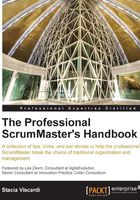
What this book covers
Chapter 1, Scrum – A Brief Review of the Basics (and a Few Interesting Tidbits), provides you with the history, philosophies, and practices of Scrum. If you're new to Scrum, you must read this chapter; and if you're experienced, read it anyway. This chapter contains the underlying reasons why this Scrum thing works. This and subsequent chapters also have a Recommended Reading section with some of my favorite websites and books for you to check out.
Chapter 2, Release Planning – Tuning Product Development, will help you help your product owner prepare the product backlog for various planning uses, while we focus on release planning specifically at this point. This chapter provides you with preparation and facilitation tips to have you up and running a release planning session in no time.
Chapter 3, Sprint Planning – Fine-tune the Sprint Commitment, suggests ways for you to envision, prepare, and facilitate sprint planning meetings, but more importantly, how to set your team up for success in a sprint.
Chapter 4, Sprint! Visible, Collaborative, and Meaningful Work, gets into the heart of the sprint—what happens day to day, how team members should work together, and how you can clear the path for team productivity. And what about that pesky daily Scrum? Yep, we get into that too!
Chapter 5, The End? Improving Product and Process One Bite at a Time, suggests that what you consider the end of a sprint is really only a pause that sets up the beginning of the next. Learn how sprint reviews and retrospectives help teams build trust with business stakeholders, and learn how retrospectives build a team.
Chapter 6, The Criticality of Real-time Information, presents ideas for giving visibility to your team's work so that the product owner and other business stakeholders can make smart decisions. You'll learn how to help the right people look through the lenses of the Scrum microscope so that they may make smart and timely decisions.
Chapter 7, Scrum Values Expose Fear, Dysfunction, and Waste, walks you through the five core values of Scrum and the top five responses of reluctant teams and organizations.
Chapter 8, Everyday Leadership for the ScrumMaster and Team, gives ideas and tips for you to hone your personal skills in order to make your team as strong as it can be. This is preparation for Chapter 9, Shaping the Agile Organization.
Chapter 9, Shaping the Agile Organization, expands on Chapter 8, Everyday Leadership for the ScrumMaster and Team, by turning your attention to the organization outside the team. We'll explore motivation for knowledge workers, HR carrots and sticks, Agile organizational structures, and the like.
Chapter 10, Scrum – Large and Small, gives you some ideas for scaling the Scrum framework to accommodate larger multi-team programs. We'll also delve a little into distributed teams.
Chapter 11, Scrum and the Future, will take you on a journey to the future world of knowledge work, what organizations will look like, and how, if done with serious professionalism, ScrumMasters can make that happen sooner rather than later.
Appendix A, ScrumMaster's Responsibilities, provides a run-down of ScrumMaster responsibilities and duties. You can use this list as a quick way to stock your Impediment Backlog.
Appendix B, ScrumMaster's Workshop, is full of thought-provoking questions, scenarios, and exercises—broken out by chapter—for you to work through and think about while reading the book. This appendix is also available online for download at http://www.packtpub.com/sites/default/files/downloads/AppendixB_scrum_master_workshop.pdf.
I created a companion website, www.helloscrum.com, to provide you with more ideas, tips, and tricks to help you along your way.